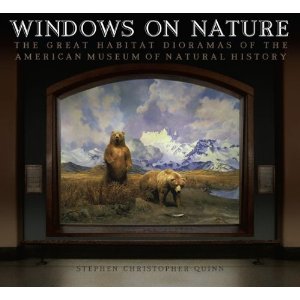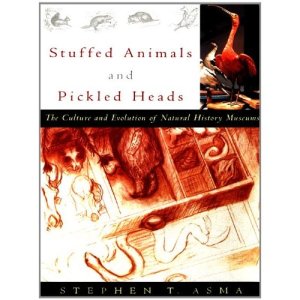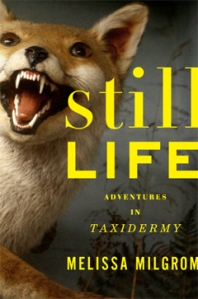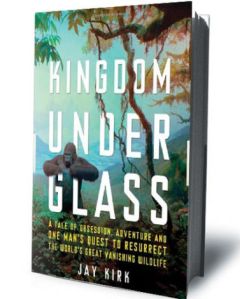Dear members of the Jenks Society and other interested persons,
On behalf of the late Professor J.W.P. Jenks, I will be recommending a few books on the topics: Natural History, Taxidermy, Taxidermists, Museums, Wildlife Conservation and Contemporary Art. All topics that are in some way or another related to the efforts of the Jenks Society for Lost Museums and their work restoring and reinvigorating the memory and museum of Jenks.

The Breathless Zoo by Rachel Poliquin
For starters, I would like say that Rachel Poliquin, a curator in Vancouver, is the brains behind my favorite blog: Ravishing Beasts (http://www.ravishingbeasts.com/). Many of the books I’ll be writing about here are ones that I found out about from her recommended reading. Ravishing Beasts covers all things that bring together taxidermy, art and history. Please explore her blog if you haven’t already and be amazed.
The Breathless Zoo is one of the few books that looks at taxidermy and it’s relationship to Western culture. Poliquin has split taxidermy into multiple categories from specimen to hunting trophy and then writes about what those different categories mean to our culture in both historical and contemporary contexts. Also, there is a blurb on the back written by our friend Mark Dion, so you know it must be good! Plus the photos and layout of this book are beautiful and it fits somewhere between a coffee table book and philosophy.
This book covers the history of natural history and the strange evolution of taxidermy and how it’s been done. It is a fairly dense text and text is packed on to the page as if there was a paper shortage! But I do credit it for the majority of my natural history nerd cred and my ability to place names and accomplishments of random and obscure naturalists. Be warned that this book is very hard to find and pricy when you do. Check for it at libraries or get your library to buy it.

Windows on Nature by Stephen Christopher Quinn
The photos in this book are gorgeous. It takes you behind the scenes and history of the dioramas at the American Museum of Natural History Museum in New York. Of course, the Jenks Museum at Brown never had dioramas, it was more along the lines of an organized cabinet of curiosity. In the days before David Attenborough wildlife specials, these dioramas were how people learned about the natural world. The diorama’s were used to educate people about early wildlife conservation, which is ironic since the animals had to be killed to make them. If you would like to learn about some of the vision and adventure stories behind these striking dioramas, look for Jay Kirk’s biography of Carl Akeley, which you can find a review for later on in this post.
There have been a few books recently about the behind the scene world of professional taxidermists but Melissa Milgrom’s book is by far the best. She goes to the world taxidermy competitions, the warehouse where taxidermists were restoring the mounts at the Smithsonian, the studio of Damien Hirst’s taxidermist and she even taxidermied a squirrel for competition. Each chapter reveals a new aspect of taxidermy including museums and how they are lost to time and change because of the times. This book is easy to find used online. (Be sure to support small or local book stores!)

Mr. Hornaday’s War by Stefan Bechtel
William Temple Hornaday was a pioneer in both taxidermy technique and one of America’s first wildlife conservationists. When looking at this book in context of our friend Jenks, Hornaday would have been around the age of some of his students and Horniday actually worked under a friend of Jenks’ at the Smithsonian. Many of the photo’s we are using as reference material on the Jenks project are from Hornaday’s time at the museum. As well as being a curator at the Smithsonian, an former employee and collector of speciems for Ward’s (a famous museum and taxidermy supplier), Hornaday started the Bronx Zoo, the New York Zoological Society, and is credited with saving the American Bison and the fur seal from extinction. This is an incredible story of how our nation’s view of the natural world changed in one man’s lifetime an dhow taxidermy, museums and zoos helped to do it. This book isn’t going to win the Pulitzer but it is a worth while read for those interested in natural history and her defenders.
Jay Kirk’s biography of Carl Aleley is at times overly written, often reading more like a novel than nonfiction. But Akeley had adventures that could rival those of Indana Jones. Carl Akeley is known as the father of modern taxidermy (though some people credit Hornaday with this) and the visionary behind the Akeley Hall of African Mammals at the American Museum of Natural History, which was named after his death on an African mountain top while hunting gorillas. Akeley is also a generation behind Jenks but he was equally obsessed with his museum. Akeley could be said to be the man who ended the Jenks style of museum, with it’s crowded shelves and scientific organization, because Akeley was one of the first people to employ the diorama in taxidermy and natural history museums. This book has natural history, taxidermy, adventure and even romance. What else do you need?

Mr. Wilson’s Cabinet of Wonder by Lawrence Wechler
in the first chapter of this book I actually started to wonder if the sticker on the front cover proclaiming this book as a work of nonfiction might be part of an elaborate work of imagination. It turns out that the fiction is the nonfiction. If that is confusing, only reading this book will clarify. Like the Jenks Society, Mr. Wilson is using the museum as art. He is the creator of the Museum of Jurassic Technology, which should be on the itinerary for your next trip to L.A. His museum blends fact and fiction, art and science. Everyone should read this book if they are interested in any combination of those things.
I hope you’ve found something to add to your reading list and to expand your knowledge on all things natural history, taxidermy and even art.
-Raina


